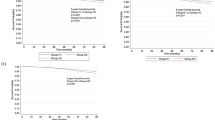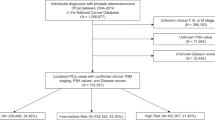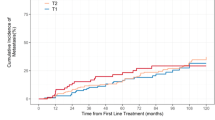Abstract
Background:
Outcomes in men with National Comprehensive Cancer Network (NCCN) high-risk prostate cancer (PCa) can vary substantially—some will have excellent cancer-specific survival, whereas others will experience early metastasis even after aggressive local treatments. Current nomograms, which yield continuous risk probabilities, do not separate high-risk PCa into distinct sub-strata. Here, we derive a binary definition of very-high-risk (VHR) localized PCa to aid in risk stratification at diagnosis and selection of therapy.
Methods:
We queried the Johns Hopkins radical prostatectomy database to identify 753 men with NCCN high-risk localized PCa (Gleason sum 8–10, PSA >20 ng ml−1, or clinical stage ⩾T3). Twenty-eight alternate permutations of adverse grade, stage and cancer volume were compared by their hazard ratios for metastasis and cancer-specific mortality. VHR criteria with top-ranking hazard ratios were further evaluated by multivariable analyses and inclusion of a clinically meaningful proportion of the high-risk cohort.
Results:
The VHR cohort was best defined by primary pattern 5 present on biopsy, or ⩾5 cores with Gleason sum 8–10, or multiple NCCN high-risk features. These criteria encompassed 15.1% of the NCCN high-risk cohort. Compared with other high-risk men, VHR men were at significantly higher risk for metastasis (hazard ratio 2.75) and cancer-specific mortality (hazard ratio 3.44) (P<0.001 for both). Among high-risk men, VHR men also had significantly worse 10-year metastasis-free survival (37% vs 78%) and cancer-specific survival (62% vs 90%).
Conclusions:
Men who meet VHR criteria form a subgroup within the current NCCN high-risk classification who have particularly poor oncological outcomes. Use of these characteristics to distinguish VHR localized PCa may help in counseling and selection optimal candidates for multimodal treatments or clinical trials.
This is a preview of subscription content, access via your institution
Access options
Subscribe to this journal
Receive 4 print issues and online access
$259.00 per year
only $64.75 per issue
Buy this article
- Purchase on Springer Link
- Instant access to full article PDF
Prices may be subject to local taxes which are calculated during checkout

Similar content being viewed by others
References
D’Amico a V, Whittington R, Malkowicz SB, Schultz D, Blank K, Broderick Ga et al. Biochemical outcome after radical prostatectomy, external beam radiation therapy, or interstitial radiation therapy for clinically localized prostate cancer. JAMA 1998; 280: 969–974.
NCCN. Clinical practice guidelines in oncology: prostate cancer. National comprehensive cancer network 2012; Version 3, Available from: NCCN.org.
Meng MV, Elkin EP, Latini DM, Duchane J, Carroll PR . Treatment of patients with high risk localized prostate cancer: results from cancer of the prostate strategic urological research endeavor (CaPSURE). J Urol 2005; 173: 1557–1561.
Loeb S, Schaeffer EM, Trock BJ, Epstein JI, Humphreys EB, Walsh PC . What are the outcomes of radical prostatectomy for high-risk prostate cancer? Urology 2010; 76: 710–714.
Cooperberg MR, Cowan J, Broering JM, Carroll PR . High-risk prostate cancer in the United States, 1990-2007. World J Urol 2008; 26: 211–218.
Pierorazio PM, Ross AE, Han M, Epstein JI, Partin AW, Schaeffer EM . Evolution of the clinical presentation of men undergoing radical prostatectomy for high-risk prostate cancer. BJU Int 2012; 109: 988–993.
Pierorazio PM, Ross AE, Lin BM, Epstein JI, Han M, Walsh PC et al. Preoperative characteristics of high-Gleason disease predictive of favourable pathological and clinical outcomes at radical prostatectomy. BJU Int 2012; 110: 1122–1128.
Yossepowitch O, Eggener SE, Serio AM, Carver BS, Bianco FJ, Scardino PT et al. Secondary therapy, metastatic progression, and cancer-specific mortality in men with clinically high-risk prostate cancer treated with radical prostatectomy. European Urol 2008; 53: 950–959.
Sundi D, Ross A, Humphreys E, Han M, Partin AW, Carter HB et al. African American men with very low risk prostate cancer exhibit adverse oncologic outcomes after radical prostatectomy. Should active surveillance still be an option for them? J Clin Oncol 2013; 31: 2991–2997.
Epstein JI, Allsbrook WC, Amin MB, Egevad LL . The 2005 international society of urological pathology (ISUP) consensus conference on gleason grading of prostatic carcinoma. Am J Surg Pathol 2005; 29: 1228–1242.
Cooperberg MR, Freedland SJ, Pasta DJ, Elkin EP, Presti JC, Amling CL et al. Multiinstitutional validation of the UCSF cancer of the prostate risk assessment for prediction of recurrence after radical prostatectomy. Cancer 2006; 107: 2384–2391.
Loeb S, Carvalhal GF, Kan D, Desai A, Catalona WJ . External validation of the cancer of the prostate risk assessment (CAPRA) score in a single-surgeon radical prostatectomy series. Urologic Oncol 2012; 30: 584–589.
Cooperberg MR, Pasta DJ, Elkin EP, Litwin MS, Latini DM, Du Chane J et al. The University of California, San Francisco Cancer of the Prostate Risk Assessment score: a straightforward and reliable preoperative predictor of disease recurrence after radical prostatectomy. J Urol 2005; 173: 1938–1942.
D’Amico AV, Chen M-H, Roehl KA, Catalona WJ . Preoperative PSA velocity and the risk of death from prostate cancer after radical prostatectomy. N Engl J Med 2004; 351: 125–135.
Kutikov A, Cooperberg MR, Paciorek AT, Uzzo RG, Carroll PR, Boorjian S . Evaluating prostate cancer mortality and competing risks of death in patients with localized prostate cancer using a comprehensive nomogram, Prostate Cancer Prostatic Diseases 2012, 1–6.
Stephenson AJ . Re: Zhao et al.: External Validation of University of California, San Francisco, Cancer of the Prostate Risk Assessment Score ( Urology 2008; 72: 396-400 ). Urology 2008; 72: 719–720.
Dotan Z, Bianco FJ, Rabbani F, Eastham J, Fearn P, Scher HI et al. Pattern of prostate-specific antigen (PSA) failure dictates the probability of a positive bone scan in patients with an increasing PSA after radical prostatectomy. J Clin Oncol 2005; 23: 1962–1968.
Slovin SF, Wilton AS, Heller G, Scher HI . Time to detectable metastatic disease in patients with rising prostate-specific antigen values following surgery or radiation therapy. Clin Cancer Res 2005; 11 (24 Pt 1): 8669–8673.
Porter CR, Suardi N, Kodama K, Capitanio U, Gibbons RP, Correa R et al. A nomogram predicting metastatic progression after radical prostatectomy. Int J Urol 2008; 15: 889–894.
Inman B, Frank I, Boorjian S, Akornor JW, Karnes RJ, Leibovich BC et al. Dynamic prediction of metastases after radical prostatectomy for prostate cancer. BJU Int 2011; 108: 1762–1768.
Freedland SJ, Humphreys EB, Mangold LA, Eisenberger M, Dorey FJ, Walsh PC et al. Risk of prostate cancer-specific mortality following biochemical recurrence after radical prostatectomy. JAMA 2013; 294: 433–439.
Eggener SE, Scardino PT, Walsh PC, Han M, Partin AW, Trock BJ et al. Predicting 15-year prostate cancer specific mortality after radical prostatectomy. J Urol 2011; 185: 869–875.
Svatek R, Karakiewicz PI, Shulman M, Karam J, Perrotte P, Benaim E . Pre-treatment nomogram for disease-specific survival of patients with chemotherapy-naive androgen independent prostate cancer. Eur Urol 2006; 49: 666–674.
Porter CR, Gallina A, Kodama K, Gibbons RP, Correa R, Perrotte P et al. Prostate cancer-specific survival in men treated with hormonal therapy after failure of radical prostatectomy. Eur Urol 2007; 52: 446–452.
D’Amico AV, Moul J, Carroll PR, Sun L, Lubeck D, Chen M-H . Cancer-specific mortality after surgery or radiation for patients with clinically localized prostate cancer managed during the prostate-specific antigen era. J Clin Oncol 2003; 21: 2163–2172.
D’Amico AV, Kote K, Loffredo M, Renshaw AA, Schultz D . Determinants of prostate cancer-specific survival after radiation therapy for patients with clinically localized prostate cancer. J Clin Oncol 2002; 20: 4567–4573.
Kattan MW, Zelefsky MJ, Kupelian P, Cho D, Scardino PT, Fuks Z et al. Pretreatment nomogram that predicts 5-year probability of metastasis following three-dimensional conformal radiation therapy for localized prostate cancer. J Clin Oncol 2003; 21: 4568–4571.
Cooperberg MR, Broering JM, Carroll PR . Risk assessment for prostate cancer metastasis and mortality at the time of diagnosis. J Natl Cancer Inst 2009; 101: 878–887.
Budaus L, Isbarn H, Tennstedt P, Salomon G, Schlomm T, Steuber T et al. Risk assessment of metastatic recurrence in Cancer of the Prostate Risk Assessment score: results from 2937 European patients. BJU Int 2012; 110: 1714–1720.
Cuzick J, Swanson GP, Fisher G, Brothman AR, Berney DM, Reid JE et al. Prognostic value of an RNA expression signature derived from cell cycle proliferation genes in patients with prostate cancer: a retrospective study. Lancet Oncol 2011; 12: 245–255.
Moul JW, Wu H, Sun L, McLeod DG, Amling C, Donahue T et al. Early versus delayed hormonal therapy for prostate specific antigen only recurrence of prostate cancer after radical prostatectomy. J Urol 2008; 171 (March 2004): 1141–1147.
Nielsen ME, Trock BJ, Walsh PC . Salvage or adjuvant radiation therapy: counseling patients on the benefits. J Natl Comprehensive Cancer Network 2010; 8: 228–237.
Zelefsky MJ, Eastham JA, Cronin AM, Fuks Z, Zhang Z, Yamada Y et al. Metastasis after radical prostatectomy or external beam radiotherapy for patients with clinically localized prostate cancer: a comparison of clinical cohorts adjusted for case mix. J Clin Oncol 2010; 28: 1508–1513.
Hoffman RM, Koyama T, Fan K-H, Albertsen PC, Barry MJ, Goodman M et al. Mortality after radical prostatectomy or external beam radiotherapy for localized prostate cancer. J Natl Cancer Inst 2013; 105: 711–718.
Acknowledgements
NIH Training Grant T32DK007552 (DS), Howard Hughes Clinician-Scientist Early Careers Award (EMS), AUA/Astellas Rising Star Award (EMS) and Johns Hopkins Clinician Scientist Award (AER)
Author information
Authors and Affiliations
Corresponding author
Ethics declarations
Competing interests
The authors declare no conflict of interest.
Additional information
Supplementary Information accompanies the paper on the Prostate Cancer and Prostatic Diseases website
Rights and permissions
About this article
Cite this article
Sundi, D., Wang, V., Pierorazio, P. et al. Very-high-risk localized prostate cancer: definition and outcomes. Prostate Cancer Prostatic Dis 17, 57–63 (2014). https://doi.org/10.1038/pcan.2013.46
Received:
Revised:
Accepted:
Published:
Issue Date:
DOI: https://doi.org/10.1038/pcan.2013.46
Keywords
This article is cited by
-
Surgical Management and Considerations for Patients with Localized High-Risk Prostate Cancer
Current Treatment Options in Oncology (2024)
-
Revisiting current National Comprehensive Cancer Network (NCCN) high-risk prostate cancer stratification: a National Cancer Database analysis
Prostate Cancer and Prostatic Diseases (2023)
-
Biochemical recurrence after chemohormonal therapy followed by robot-assisted radical prostatectomy in very-high-risk prostate cancer patients
Journal of Robotic Surgery (2023)
-
An external validation of the Candiolo nomogram in a cohort of prostate cancer patients treated by external‐beam radiotherapy
Radiation Oncology (2021)
-
Surgical management of high-risk, localized prostate cancer
Nature Reviews Urology (2020)



